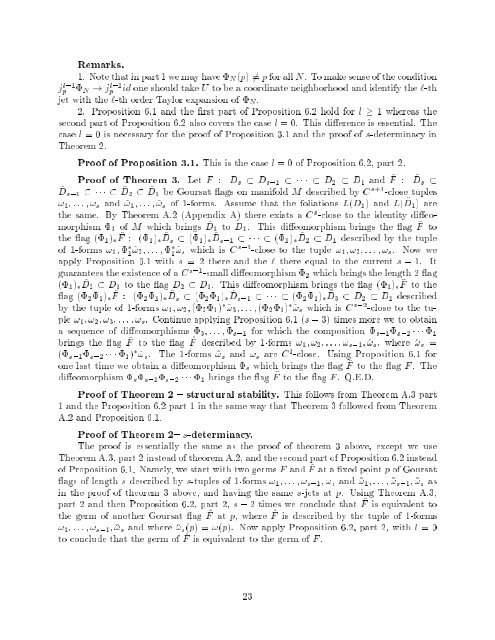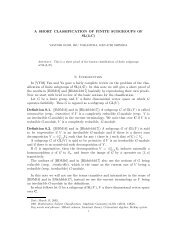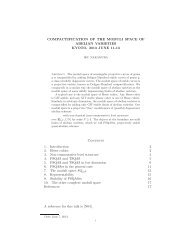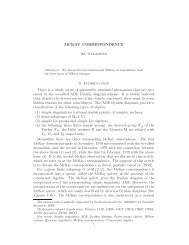GEOMETRIC APPROACH TO GOURSAT FLAGS * Richard ...
GEOMETRIC APPROACH TO GOURSAT FLAGS * Richard ...
GEOMETRIC APPROACH TO GOURSAT FLAGS * Richard ...
- No tags were found...
You also want an ePaper? Increase the reach of your titles
YUMPU automatically turns print PDFs into web optimized ePapers that Google loves.
Remarks.1. Note that in part 1 wemayhave N (p) 6= p for all N. Tomakesense of the conditionj l;1p N ! j l;1pid one should take U to be a coordinate neighborhood and identify the `-thjet with the `-th order Taylor expansion of N .2. Proposition 6.1 and the rst part of Proposition 6.2 hold for l 1whereas thesecond part of Proposition 6.2 also covers the case l =0. Thisdierence is essential. Thecase l =0is necessary for the proof of Proposition 3.1 and the proof of s-determinacy inTheorem 2.Proof of Proposition 3.1. This is the case l =0of Proposition 6.2, part 2.Proof of Theorem 3. Let F : D s D s;1 D 2 D 1 and ~ F : ~ Ds ~D s;1 ~ D2 ~ D1 be Goursat ags on manifold M described by C s+1 -close tuples! 1 :::! s and ~! 1 :::~! s of 1-forms. Assume that the foliations L(D 1 ) and L( ~ D 1 ) arethe same. By Theorem A.2 (Appendix A) there exists a C s -close to the identity dieomorphism 1 of M which brings D ~ 1 to D 1 . This dieomorphism brings the ag F ~ tothe ag ( 1 ) F ~ : (1 ) Ds ~ ( 1 ) Ds;1 ~ ( 1 ) D2 ~ D 1 described by thetupleof 1-forms ! 1 1 ~! 2::: 1 ~! s which isC s;1 -close to the tuple ! 1 ! 2 :::! s . Now weapply Proposition 6.1 with s =2there and the ` there equal to the current s ; 1. Itguarantees the existence of a C s;1 -small dieomorphism 2 which bringsthe length 2 ag( 1 ) D2 ~ D 1 to the ag D 2 D 1 . This dieomorphism brings the ag ( 1 ) F ~ to theag ( 2 1 ) F ~ : (2 1 ) Ds ~ ( 2 1 ) Ds;1 ~ ( 2 1 ) D3 ~ D 2 D 1 describedby the tuple of 1-forms ! 1 ! 2 ( 2 1 ) ~! 3 :::( 2 1 ) ~! s which isC s;2 -close to the tuple! 1 ! 2 ! 3 :::! s . Continue applying Proposition 6.1 (s ; 3) times more we toobtaina sequence of dieomorphisms 3 ::: s;1 for which thecomposition s;1 s;2 1brings the ag F ~ to the ag ^F described by 1-forms !1 ! 2 :::! s;1 ^! s ,where^! s =( s;1 s;2 1 ) ~! s . The 1-forms ^! s and ! s are C 1 -close. Using Proposition 6.1 forone last time we obtain a dieomorphism s which brings the ag ^F to the ag F . Thedieomorphism s s;1 s;2 1 brings the ag F ~ to the ag F . Q.E.D.Proof of Theorem 2 { structural stability. This follows from Theorem A.3 part1 and the Proposition 6.2 part 1 in the same way that Theorem 3 followed from TheoremA.2 and Proposition 6.1.Proof of Theorem 2{ s-determinacy.The proof is essentially the same as the proof of theorem 3 above, except we useTheorem A.3, part 2 instead of theorem A.2, and the second part of Proposition 6.2 insteadof Proposition 6.1. Namely, we start with two germs F and ~ F at a xed point p of Goursatags of length s described by s-tuples of 1-forms ! 1 :::! s;1 ! s and ~! 1 :::~! s;1 ~! s asin the proof of theorem 3 above, and having the same s-jets at p. Using Theorem A.3,part 2 and then Proposition 6.2, part 2, s ; 2times we conclude that ~ F is equivalent tothe germ of another Goursat ag ^F at p, where ^F is described by thetuple of 1-forms! 1 :::! s;1 ^! s and where ^! s (p) =!(p). Now apply Proposition 6.2, part 2, with l =0to conclude that the germ of ^F is equivalent tothe germ of F .23





